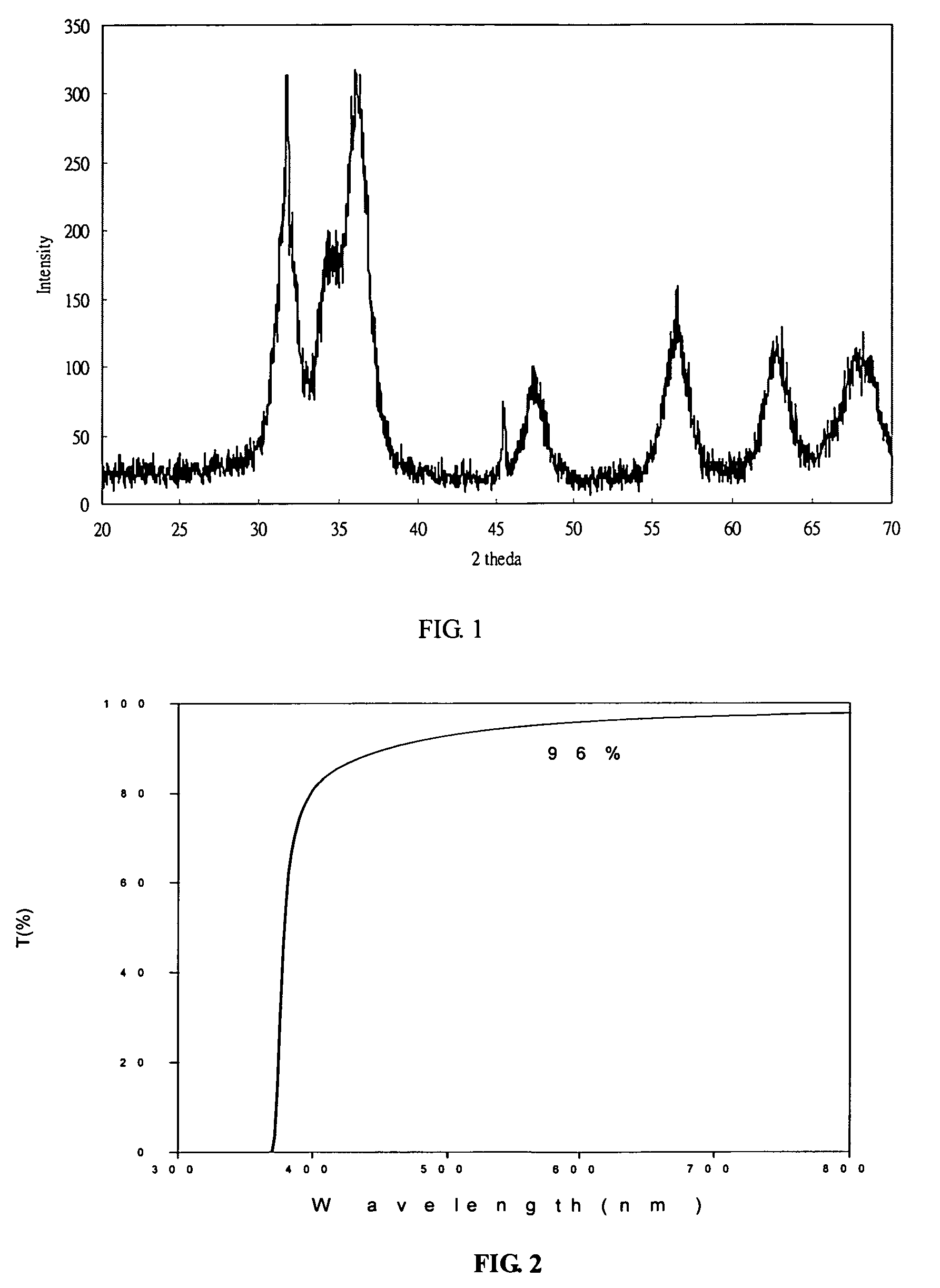Preparation method for nanometer grade zinc oxide crystalline (zincite) sol
a technology of nanoparticles and zinc oxides, applied in the field of preparation of nanoparticle sols of zinc oxide (zincite), can solve the problems of less preferred solvents in the industry, less preferred chemicals, and less volatile chemicals, and achieves strong uv absorption, less preferred, and high volatility and toxicity
- Summary
- Abstract
- Description
- Claims
- Application Information
AI Technical Summary
Benefits of technology
Problems solved by technology
Method used
Image
Examples
example 1
[0025]136 g of zinc chloride dehydrate is added to 450 mL of ethylene glycol, stir about 20˜30 minutes under 60 deg C to prepare 500 mL of 2M inorganic zinc acidic solution. At the same time, 80 g of sodium hydroxide is added to 960 mL of water containing ethylene glycol to prepare a 2M alkaline solution. The acidic solution and the alkaline solution are fed to a reactor containing 1200 mL of ethylene glycol at a constant rate, while controlling the hydrolysis to occur at pH 9.0. Whitish precipitate is produced during hydrolysis. The final content in the reactor is heated at 80 deg C for 2 hours, and converted to a transparent zinc oxide (zincite) nanoparticle sol. The zinc oxide content in this sol is about 2.5 wt %. X-ray diffraction pattern of a dried sample shows zincite hexagonal crystalline structure. The crystalline domain size estimated by Scherrer equation is 5.4 nm. When the sol is diluted 20 times and subjected to UVVIS spectroscopic measurement, the absorption edge occur...
example 2
[0026]The procedures described in the Example 1 are repeated to prepare an ethylene glycol solution with whitish precipitate. The precipitate is thickened by filter out the excess supernatant until 407 g of white slurry is obtained. The slurry is heated at 80 deg C for 2 hours, and converted to a transparent sol of concentrated sol of zinc oxide nanoparticles. The zinc oxide content in this concentrated sol is about 20 wt %. Even at this concentration, the sol is still transparent to visible light and has a transmission greater than 90% at 600 nm as showed in FIG. 1. X-ray diffraction pattern of a dried sample shows zincite hexagon crystalline structure in FIG. 2. The crystalline domain size is about 5.7 nm by Scherrer equation estimated from the half-width of the major peak. The particle size distribution obtained by DLS (Dynamic Light Scattering) on a 200 time diluted sample is shown in FIG. 3. The TEM micrograph is shown in FIG. 4, which clearly indicates the particle size is sma...
PUM
| Property | Measurement | Unit |
|---|---|---|
| particle size | aaaaa | aaaaa |
| particle size | aaaaa | aaaaa |
| size | aaaaa | aaaaa |
Abstract
Description
Claims
Application Information
 Login to View More
Login to View More - R&D
- Intellectual Property
- Life Sciences
- Materials
- Tech Scout
- Unparalleled Data Quality
- Higher Quality Content
- 60% Fewer Hallucinations
Browse by: Latest US Patents, China's latest patents, Technical Efficacy Thesaurus, Application Domain, Technology Topic, Popular Technical Reports.
© 2025 PatSnap. All rights reserved.Legal|Privacy policy|Modern Slavery Act Transparency Statement|Sitemap|About US| Contact US: help@patsnap.com



